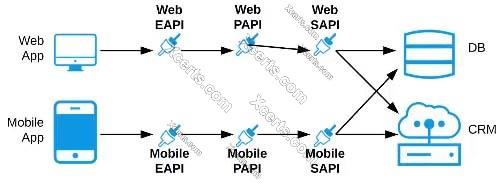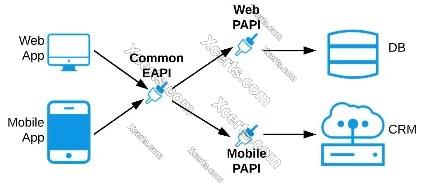Refer to the exhibit.

An organization needs to enable access to their customer data from both a mobile app and a web application, which each need access to common fields as well as certain unique fields.
The data is available partially in a database and partially in a 3rd-party CRM system. What APIs should be created to best fit these design requirements?
A) A Process API that contains the data required by both the web and mobile apps, allowing these applications to invoke it directly and access the data they need thereby providing the flexibility to add more fields in the future without needing API changes

B) One set of APIs (Experience API, Process API, and System API) for the web app, and another set for the mobile app

C) Separate Experience APIs for the mobile and web app, but a common Process API that invokes separate System APIs created for the database and CRM system

D) A common Experience API used by both the web and mobile apps, but separate Process APIs for the web and mobile apps that interact with the database and the CRM System

- Option A
- Option B
- Option C
- Option D
Answer(s): C
Explanation:
Correct Answer: Separate Experience APIs for the mobile and web app, but a common Process API that invokes separate System APIs created for the database and CRM system
***************************************** As per MuleSoft's API-led connectivity:
>> Experience APIs should be built as per each consumer needs and their experience.
>> Process APIs should contain all the orchestration logic to achieve the business functionality.
>> System APIs should be built for each backend system to unlock their data.
Reference:
https://blogs.mulesoft.com/dev/api-dev/what-is-api-led-connectivity/
